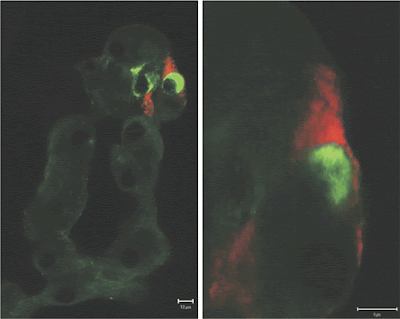Our
Ret-Catolog#: GT15002 is referenced in the publication:
Bhupinder P.S. Vohra , William Planer , Jennifer Armon , Ming Fu , Sanjay Jain , Robert O. Heuckeroth Reduced endothelin converting enzyme-1 and endothelin-3 mRNA in the developing bowel of male mice may increase expressivity and penetrance of Hirschsprung disease-like distal intestinal aganglionosisDevelopmental Dynamics 236:106–117, 2007... goat anti-Ret antibody (Neuromics,. Inc., Minneapolis, MN, 1:200)...

Figure 2. Testosterone and Mullerian inhibiting substance (MIS) do not have deleterious effects on enteric nervous system (ENS) precursor proliferation, differentiation, or survival. A-D: Cultured immunoselected embryonic day (E) 12.5 C57BL/6 ENS precursors were grown for 24 hr with or without glial cell line-derived neurotrophic factor (GDNF), testosterone, or MIS. A-C: Triple-label immunohistochemistry was performed with antibodies to Ret (A), neuron-specific beta III tubulin (TuJ1; B), or histone 3 phosphate (H3P; C). D: Shows the merged image. Arrowheads show a Ret+ TuJ1+ H3P- cell. Arrows identify a cell with a punctate nuclear staining pattern characteristic of H3P immunohistochemistry. Both TuJ1 and H3P antibodies were generated in rabbits, but easily were distinguished based on characteristic staining patterns. E,H: Quantitative analysis of TuJ1 immunoreactivity in Ret+ cells shows that treatment with testosterone or MIS does not alter expression of the neuronal differentiation marker recognized by TuJ1 in the presence or absence of GDNF. F,I: Quantitative analysis of proliferation (H3P+ cells) shows that neither testosterone nor MIS influences proliferation of Ret+TuJ1+ cells in the presence or absence of GDNF. G,J: Quantitative analysis of proliferating Ret+TuJ1- cell demonstrates increased proliferation in response to testosterone, but not MIS in the absence of GDNF. There was no additive effect of testosterone plus GDNF under these conditions. Asterisks indicate P < n =" 3" bar =" 50">





